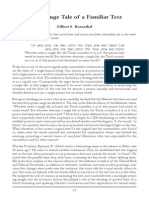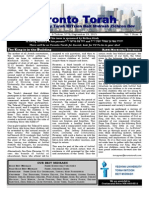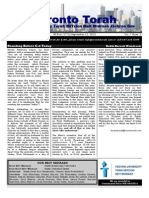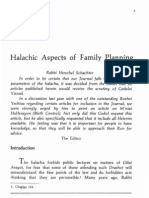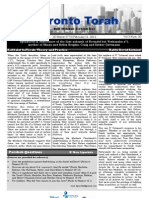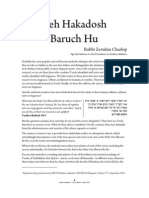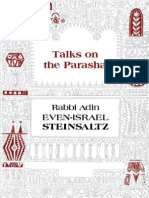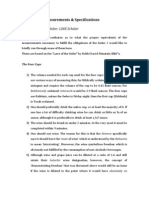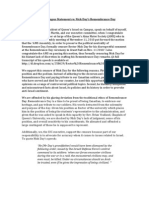The Power of Preparation
The Power of Preparation
Uploaded by
outdash2Copyright:
Available Formats
The Power of Preparation
The Power of Preparation
Uploaded by
outdash2Original Title
Copyright
Available Formats
Share this document
Did you find this document useful?
Is this content inappropriate?
Copyright:
Available Formats
The Power of Preparation
The Power of Preparation
Uploaded by
outdash2Copyright:
Available Formats
Parshat Noach
4 Cheshvan, 5776/October 17, 2015
Vol. 7 Num. 6
This issue of Toronto Torah is dedicated by Jeffrey and Rochel Silver in honour of their parents
The Power of Preparation
A righteous man (ish), perfect in
his generations In any place it
says ish, it means someone who is
righteous and a tested expert.
[Noach was called an (ish),] for all
120 years leading up to the flood he
planted cedar trees and cut them
down. People asked him, Why are
you doing this? Noach would
respond, The Master of the world
stated that He will bring a flood to
the world. (Bereishit Rabbah 30:7)
Noach planted trees and then
harvested them for their wood,
preparing for the construction of the
ark by stockpiling the lumber. The
most basic goal of the ark was to
provide an escape for Noach and his
family from the flood that loomed in
the future. The process of building the
ark was aimed at perhaps a more
critical goal, to catch the attention of
the world and persuade them to
correct their ways. It is striking that,
according to this midrash, while the
ark was certainly the final product of
this process, the preparation was the
real focus.
Had it ended differently, Noachs story
would have presented us with an
example of how our actions can impact
the lives of others. Unfortunately, not
only did the building of the ark fail to
convince the world of the impending
disaster, it seems that even Noach had
his doubts. So steadfast was his
refusal to truly believe that a flood was
coming that Noach didnt enter the ark
until the rising water left him no
choice. (Rashi to Bereishit 7:7)
Perhaps his own lack of commitment
was the source of his failure to
influence others.
Yisroel Meir Rosenzweig
What, however , could be accomplished
if one undertook preparing for a mitzvah
wholeheartedly? In the opening to
Hilchot Rosh HaShanah (Orach Chaim
581), the Tur quotes a midrash that can
help to answer this question.
On Yom HaKippurim, all afflict
themselves - men women and
children. The Holy One Blessed is He
says to Israel, What has passed has
gone, from now and onward will be
the accounting [of sin]. From Yom
HaKippurim until Succot all of Israel
is busy with mitzvot. This one
prepares his sukkah, this one his
lulav. On the first day of Yom Tov all
of Israel stands before The Holy One
Blessed is He with their lulavim and
etrogim for the name of G-d. [G-d]
says to them, What has passed has
gone, from now will be the
accounting [of sin]. (Vayikra Rabbah
30:7)
In his commentary to Shulchan Aruch,
Turei Zahav (OC 581:1), Rabbi David
HaLevi Segal struggles to understand
this midrash. How is it possible that the
days between Yom Kippur and Succot
during which we ready ourselves for the
mitzvot of Succot are of greater spiritual
standing than the days of Succot
themselves, when we actually perform
the mitzvot of the holiday?! The Turei
Zahav suggests that these days are so
filled with preparation that there isnt
any time left in which one could sin. As
such, he rejects the notion that the
days between Yom Kippur and Succot
are of unique, intrinsic spiritual
greatness; they are made great by the
fact that we are too busy to sin.
Yehudah Aryeh Leib Alter, offers a very
different understanding. The Sefat Emet
argues that the preparation for a
mitzvah can indeed have a deeper,
longer lasting impact upon a person
that the actual performance of the
mitzvah. The mitzvah itself often only
lasts for a fleeting moment in time; the
desire and effort put into attaining that
moment can inspire us for a lifetime.
While the Sefat Emet describes the
religious experience of the individual,
this midrash does more. It begins by
emphasizing each individuals
preparation for Succot without mention
of the collective. However, with the
entrance of Succot, the emphasis shifts
to the collective. Perhaps this is the
message that one can impact the
community only once one has properly
readied himself and perhaps this is
why Noach failed.
As we perform mitzvot in our own lives,
we should consider the power of fully
engaging the process of getting ready to
perform a mitzvah and committing
wholeheartedly
to
it.
By
impacting ourselves through
preparation, we have an opportunity to
breathe new life into others
performance of mitzvot.
yrosenzweig@torontotorah.com
The Sefat Emet (Haazinu 5634), Rabbi
OUR BEIT MIDRASH
ROSH BEIT MIDRASH
RABBI MORDECHAI TORCZYNER
SGAN ROSH BEIT MIDRASH
RABBI JONATHAN ZIRING
AVREICHIM RABBI DAVID ELY GRUNDLAND, YISROEL MEIR ROSENZWEIG
CHAVERIM DAR BARUCHIM, YEHUDA EKLOVE, URI FRISCHMAN, AVISHAI GASNER,
SHMUEL GIBLON, MICHAEL IHILCHIK, RYAN JENAH, SHIMMY JESIN, CHEZKY MECKLER,
ZACK MINCER, JOSH PHILLIP, JACOB POSLUNS, SHAI REEF, ARYEH ROSEN, SHLOMO
SABOVICH, ARIEL SHIELDS, DAVID SUTTNER, DAVID TOBIS
We are grateful to
Continental Press 905-660-0311
Book Review: The Iggeret of Rav Sherira Gaon
The Iggeret of Rav Sherira Gaon
Moznaim (1988)
Translated and annotated by
Rabbi Nosson Dovid Rabinowich
Background
Rav Sherira Gaon was born in 906 CE
and died in 1006 CE. He served as the
head of the academy in Pumbedita
(close to modern day Fallujah in central
Iraq), and his son Rav Hai Gaon served
as the Nasi (president) of the academy,
taking over the leadership after Rav
Sheriras death.
During Rav Sheriras lifetime, there was
strong Karaite opposition to the
authority of the Talmud and those who
lived by it. As such, leaders from the
Kairouan community (in Tunisia) sent a
letter addressed to both Rav Sherira
an d Ra v H a i a sk i n g for h e l p
understanding the stages of
development of the oral tradition, from
its inception until their day. The Iggeret
is Rav Sheriras response.
Content
The Iggeret, while ultimately a
historical document, chronicles not only
the unbroken chain of the oral
tradition, but also where there were
indeed cracks in that chain and why
certain traditions are given more
credence then others. For example, Rav
Sherira Gaon specifically identifies the
destruction of the Beit Hamikdash and
the destruction of Beitar as the
turning points at which a single,
united tradition became a multiplicity
of views, all claiming equal authority.
The relationships between sages are
mentioned, delineating who taught
who, and which traditions each house
of study followed.
The conditions leading up to the
redaction of the Mishnah by Rebbe are
clearly stated. as are the details of how
it was compiled and how it is different
from the Tosefta. He also describes the
beraitot, both those that were studied
and eventually included in the Talmud
and those that were dismissed and
rejected. He discusses the reasoning
for their non-inclusion in the Mishnah
and explains why certain beraitot were
included in the Talmud.
Rav Sherira also explains how the
Talmud was compiled by Ravina and
Rav Ashi, outlining their means of
collecting all of the teachings of our
sages and the principles they used in
ordering the Talmud.
A great strength of the Iggeret is not
only the information and history that
Rav Sherira makes available, but the
fact that everything that is stated is
clearly established using examples and
sources found within the text of the
613 Mitzvot: #463: Cross-Examination
In the context of the laws of ir hanidachat (to be discussed
next week, G-d-willing), the Torah warns, And you shall seek
out, and you shall investigate, and you shall inquire
well. (Devarim 13:15) The Talmud (Sanhedrin 40a-b) cites
this passage as the basis for the Jewish judicial practice of
cross-examining witnesses; Sefer haChinuch records this as
the Torahs 463rd mitzvah. As Sefer haChinuch writes,
Anyone with eyes in his head will look and see that the
multiplicity of instructions, and the Torahs repetition in
different words, are meant to instruct us well in this matter.
This is a matter of great magnitude and a powerful pillar, on
which the blood of peoples lives depends. Sefer haChinuch
also connects this mitzvah with the admonition to judges in
Pirkei Avot (1:1), Be patient in judgment.
Rambam explains that the goal of cross-examination is to
ferret out falsehood both directly and indirectly. He writes,
We ask about fine details, and we shift them from subject to
subject when questioning them, so that they will be silent or
recant if there is falsehood in their testimony. (Mishneh
Torah, Hilchot Edut 1:4)
The first stage of investigation is called chakirot. The basic
set of seven chakirot establishes day, time and place, but the
judges may add unlimited chakirot related to the details of
the event which was witnessed. The witness must be able to
respond to all of the questions; a response of I dont know
to any of these questions is sufficient to disqualify the
witness. (Mishneh Torah, Hilchot Edut 1:4, 2:1)
Rabbi David Ely Grundland
Talmud itself, although not necessarily
expressed explicitly therein.
Beyond proving the halachic
significance of the Talmud and the oral
tradition, Rav Sherira also defines the
locations and chain of leadership of
each of the Torah centres during the
various periods. He records which
scholars overlapped with whom, the
various historical conditions they faced
in their respective periods, the
upheavals they experienced and the
choices that resulted.
Translation and Notes
The book is written in a combination of
rich Hebrew and Aramaic. The
accompanying translation is very
h el pful in makin g the often challenging original more
approachable for the layperson. The
notes are also a great asset, giving
even greater context to Rav Sheriras
Gaonic masterpiece.
Recommendation
Anyone who is interested in Jewish
history or in gaining greater insight
into the world of Torah and halachah
that we have today would be wellserved by studing this book. It
enlightens and enlivens the rich
history of which we are all a part.
dgrundland@torontotorah.com
Rabbi Mordechai Torczyner
The second stage of investigation is called bedikot. Bedikot
are questions about less significant and relevant aspects of
the event which was witnessed; Rambams examples include
the colour of the clothing worn by the people involved in the
event. Judges have the discretion to ask as many of these
questions as they wish, and asking more of these questions
is considered praiseworthy. Testimony is valid even if the
witnesses are unable to answer bedikot, but a contradiction
between the witnesses would disqualify their testimony.
(Mishneh Torah, Hilchot Edut 1:6, 2:1)
There is an exception to the process of cross-examination,
for cases of loans. Lines of credit are critical for society, but
the Torah makes lending unattractive by denying usury.
Therefore, the sages attempted to remove legal obstacles
which would make lending and collecting more challenging.
As part of this effort, the sages minimized the interrogation
process for witnesses to loans. (Mishneh Torah, Hilchot
Edut 3:1-2)
One might wonder whether the arduous process of
interrogation might discourage witnesses from testifying.
While the Torah does obligate those who know testimony to
come forward (Sefer haChinuch 122), might the challenge of
cross-examination prove too intimidating? The answer,
presumably, is that the Torahs fear of improper
punishment outweighs its fear of a stifled judicial system.
torczyner@torontotorah.com
Visit us at www.torontotorah.com
Biography
Torah and Translation
Rabbi Shimon Shkop
Critical Thinking in Torah Study
Rabbi Baruch Weintraub
Rabbi Shimon Shkop, Shaarei Yosher, Introduction
Translated by Rabbi Baruch Weintraub
Rabbi Shimon Shkop was born in 1860,
in Chistyakovo, Russia. Recognized for
his unique abilities, he was sent, before
the age of twelve, to the Mir Yeshiva. Two
years later he entered the Volozhin
Yeshiva, where he studied under the
Torah giants of the generation, Rabbi
Naftali Tzvi Berlin and Rabbi Chaim
Soloveitchik (later known as Rav Chaim
of Brisk). He was chosen for an elite
group of students who learned closely
with Rav Chaim, and during the ensuing
six years he absorbed the new analytical
method his mentor had developed.
Rabbi Eliezer Gordon of Telz, head of
another renowned yeshiva, arranged for
the young scholar to marry Leah, his
niece. Four years later Rabbi Shkop
moved to Telz, where he served as Rabbi.
He stayed there for more than fifteen
years, creating his own adaption of the
Brisker method. In contrast to his
mentor, Rabbi Shkop asked why as
well as what regarding halachic issues,
using reasoning to penetrate not only the
mechanism of halachah, but also its very
foundations.
The purists among Rabbi Chaims
students and successors did not favour
Rabbi Shkops approach, objecting to
both the general method and some of its
specific applications. However, many
other Torah scholars saw this approach
as a natural development. A steady flow
of students came to learn from Rabbi
Shkop, and he became known as one of
the greatest minds of his generation.
In 1920, Rabbi Shkop was invited to take
the position of Rosh Yeshiva in Grodno,
Poland. His presence there made the
Yeshiva a much sought-after place of
study, and hundreds of students came to
learn under Rabbi Shkop. The students
included Torah leaders of the next
generation, including Rabbi Yechezkel
Sarna, Rosh Yeshiva of Chevron; Rabbi
Chaim Leib Shmuelevitz, Rosh Yeshiva of
Mir; Rabbi Shmuel Rozovsky, Rosh
Yeshiva of Ponevezh; and Chaim Moshe
Shapira, a prominent Mirzachi politician
and a signatory of Israels Declaration of
Independence.
In October 1939, a month after the start
of WWII, Rabbi Shimon Shkop passed
away, but his Torah and his reputation
are still alive among us.
bweintraub@torontotorah.com
Visit us at www.torontotorah.com
,
?
,
,
,
,
... :
It would be appropriate to know and
understand what our Sages said in
Chagigah 15b: How could Rabbi Meir
learn Torah from the mouth of Acher
(Elisha ben Avuyah, the sage who
rebelled against G-d)? Didnt Rabbah
bar bar Chanah say in the name of
Rabbi Yochanan: What is the meaning of
the verse, For the kohens lips will
guard wisdom, and they will seek
knowledge of Torah from his mouth, for
he is an angel of G-d (Malachi, 2:7)?
This means that if the Rabbi is similar
to an angel of G-d, they should seek
Torah from his mouth, but if not, they
should not seek Torah from his mouth!
And the talmudic passage concludes
that there is a difference between an old
and young student
,
,
, ,
,
.
,
,
.
When we look carefully we see that
Rabbi Yochanan said that they will
seek Torah from his mouth, and did
not say, they will learn from him. In
truth, one who learns from his friend
does not learn from his teachers mouth,
but listens and weighs according to his
own mind, and comes to understanding.
He is not learning from the teachers
mouth but from the teachers mind.
Torah is considered Torah from the
mouth only if the student accepts the
words as heard, without critical
an al y si s. Re gar d i n g th i s Ra b b i
Yochanan said that to learn from
someones mouth is only appropriate if
the Rabbi is similar to G-ds angel.
, ,
,
.
According to this, Rabbi Yochanans
wording hinted at the difference between
an experienced and a young student. A
young student learns Torah from the
mouth, for he is not capable of critical
analysis, to determine what to accept
and what not to. An older student can
analyze criticically, so he doesnt learn
from the mouth.
, ,
...
,
,
.
In the same way, it would be appropriate
to encourage everyone who studies
books written in recent generations, that
they should not learn Torah from their
mouths, that they should not take
anything written in them as a
foundation before analyzing it well For
whenever it is within our power to learn
from the beginning, we should do it
independently, to the extent that has
been permitted to us to explore and
contemplate, and not to rely on the great
scholars who came before us.
This Week in Israeli History: 9 Cheshvan 1994
The 1994 Nobel Peace Prize
9 Cheshvan is Thursday
On September 13, 1993, Israeli Prime Minister Yitzchak
Rabin and PLO Chairman Yasser Arafat signed the Oslo
Accords at the White House. A little over one year later, on
October 14 (9 Cheshvan), 1994, the Norwegian Nobel
Committee awarded the Nobel Peace Prize to the two men,
as well as Israeli Foreign Minister Shimon Peres.
The committee explained, For several decades, the conflict
between Israel and its neighbour states, and between
Israelis and Palestinians, has been among the most
irreconcilable and menacing in international politics. The
parties have caused each other great suffering. By
concluding the Oslo Accords, and subsequently following
them up, Arafat, Peres and Rabin have made substantial
contributions to a historic process through which peace and
cooperation can replace war and hate The award of the
Nobel Peace Prize for 1994 to Arafat, Peres and Rabin is
intended by the Norwegian Nobel Committee to honour a
political act which called for great courage on both sides,
Rabbi Mordechai Torczyner
and which has opened up opportunities for
development towards fraternity in the Middle East.
new
Moments after the award was announced, Kare Kristiansen
resigned from the Nobel committee. He asked, What
consequences will result when a terrorist with such a
background is awarded the worlds most prestigious prize?
Kristiansen said of Arafat, His past is too tainted with
violence, terrorism and bloodshed, and his future too
unpredictable to make him a Nobel Peace Prize winner.
Kristiansen went on to become an outspoken opponent of
Israels Disengagement from Gaza; he passed away in 2005.
Just hours after the Nobel announcement, Israeli commandos
from Sayeret Matkal raided a terrorist stronghold where
Hamas terrorists were holding Nachshon Waxman hostage.
The raid failed; Nachshon Waxman and Commander Nir Poraz
were killed. The terrorist who murdered Waxman would be
released in 2011 in the prisoner exchange for Gilad Shalit.
torczyner@torontotorah.com
Weekly Highlights: Oct. 17 Oct. 23 / 4 Cheshvan 10 Cheshvan
Time
Speaker
Topic
Location
Special Notes
After hashkamah
Yisroel Meir Rosenzweig
Seforno on the Parshah
Clanton Park
After hashkamah
R David Ely Grundland
The Good Ol Days
Shaarei Shomayim
Before minchah
R Jonathan Ziring
Daf Yomi
BAYT
After minchah
R Mordechai Torczyner
Gemara Avodah Zarah
BAYT
8:45 AM
R Jonathan Ziring
Trei Asar
BAYT
8:45 AM
R Josh Gutenberg
Contemporary Halachah
BAYT
9:15 AM
R Shalom Krell
The Book of Shemuel
Associated (North)
Hebrew
R Aaron Greenberg
Gemara Chullin
Yeshivat Or Chaim
For Chaverim
Yeshivat Or Chaim
Beit Midrash Night
Shaarei Shomayim
Beit Midrash Night
Oct. 17
Sun. Oct. 18
10:00 AM
Hebrew
Mon. Oct. 19
7:30 PM
7:30 PM
R Jonathan Ziring
Chok haShemitah:
Torah Values, Modern Society
R David Ely Grundland Daf Highlight: Holy Haircuts
R Mordechai Torczyner
Medical Halachah
R Mordechai Torczyner
Jewish History:
Neither Jewish Nor History
Adath Israel
R Mordechai Torczyner
Job: Chapter 20
Shaarei Shomayim
10:00 AM
R Mordechai Torczyner
The Ethical Customer
Week 2: Returns
Beth Emeth
8:00 PM
Yisroel Meir Rosenzweig
Human Cloning
Shaarei Tefillah
R Mordechai Torczyner
Yehoshua: Menashehs Land
49 Michael Ct.
For women only
R Mordechai Torczyner
Eruvin: Hukaf lDirah II
Yeshivat Or Chaim
Advanced
Tue. Oct. 20
10:00 AM
1:30 PM
There is a fee
info@adathisrael.com
Wed. Oct. 21
Register with
savtaloretta@gmail.com
Thu. Oct. 22
1:30 PM
Fri. Oct. 23
10:30 AM
You might also like
- Maaneh Lashon Hebrew - English 2018 PDFDocument93 pagesMaaneh Lashon Hebrew - English 2018 PDFMoyn Both100% (1)
- Yalkut Bar MitzvahDocument176 pagesYalkut Bar MitzvahAbraham Rasgado González100% (1)
- IdolatryDocument320 pagesIdolatryAmon SakifiNo ratings yet
- Article RosenthalDocument9 pagesArticle RosenthalSoak KaosNo ratings yet
- Manuscript and Theology Study of YHWH: One Name For Father, Son, and SpiritDocument59 pagesManuscript and Theology Study of YHWH: One Name For Father, Son, and SpiritJonathan W. Lankford0% (1)
- Nefesh HaTzimtzum, Volume 2: Understanding Nefesh HaChaim through the Key Concept of Tzimtzum and Related WritingsFrom EverandNefesh HaTzimtzum, Volume 2: Understanding Nefesh HaChaim through the Key Concept of Tzimtzum and Related WritingsRating: 5 out of 5 stars5/5 (2)
- Lessons Learned From Conversion: Rabbi Zvi RommDocument5 pagesLessons Learned From Conversion: Rabbi Zvi Rommoutdash2No ratings yet
- R Yosef Goldstein MemoirsDocument26 pagesR Yosef Goldstein MemoirsHirshel Tzig100% (1)
- Counterfeit Blessings by C.G. HatonnDocument273 pagesCounterfeit Blessings by C.G. HatonnMaxine Rose100% (1)
- Hebrew For Theologians, Jacques Doukhan PDFDocument276 pagesHebrew For Theologians, Jacques Doukhan PDFJacmer Peralta Nova100% (9)
- Toronto TorahDocument4 pagesToronto Torahoutdash2No ratings yet
- A Beacon in The NightDocument4 pagesA Beacon in The Nightoutdash2No ratings yet
- Parshat Beraishit The First Man Rabbi Ari Kahn: The Torah Describes The Creation As TwilightDocument8 pagesParshat Beraishit The First Man Rabbi Ari Kahn: The Torah Describes The Creation As Twilightgavriel76No ratings yet
- The Wisdom of Chanting The Hebrew Scriptures in Synagogue, Temple, and Congregational ServicesDocument54 pagesThe Wisdom of Chanting The Hebrew Scriptures in Synagogue, Temple, and Congregational ServicesCraig Peters67% (3)
- Toronto TorahDocument4 pagesToronto Torahoutdash2No ratings yet
- The Sefer Habrit and Naaseh V'nishmahDocument5 pagesThe Sefer Habrit and Naaseh V'nishmahoutdash2No ratings yet
- The Endless Dimensions of The Siddur DialogueDocument21 pagesThe Endless Dimensions of The Siddur DialogueKaos AquariusNo ratings yet
- The Desert, The Torah and Shavuot: Chazal (Our Sages of Blessed Memory) Established The Yearly Calendar in Such A MannerDocument4 pagesThe Desert, The Torah and Shavuot: Chazal (Our Sages of Blessed Memory) Established The Yearly Calendar in Such A Manneroutdash2No ratings yet
- Torah Sparks 5767Document145 pagesTorah Sparks 5767api-3811809No ratings yet
- Teaching The Mesorah: Avodah Namely, He Is Both A Posek (Halachic Decisor) and An Educator For The EntireDocument5 pagesTeaching The Mesorah: Avodah Namely, He Is Both A Posek (Halachic Decisor) and An Educator For The Entireoutdash2No ratings yet
- An Appointment in Time 5778 - 2018Document14 pagesAn Appointment in Time 5778 - 2018David Saportas Lièvano100% (1)
- The Greatness of The Brit Milah: BereishitDocument5 pagesThe Greatness of The Brit Milah: Bereishitoutdash2No ratings yet
- Shabbat Announcements June 8Document4 pagesShabbat Announcements June 8gnswebNo ratings yet
- Non-Profit Prophet: by Eli Stahler, 12th GradeDocument8 pagesNon-Profit Prophet: by Eli Stahler, 12th Gradeoutdash2No ratings yet
- UntitledDocument24 pagesUntitledoutdashNo ratings yet
- The Transformative Nature of ShabbatDocument4 pagesThe Transformative Nature of Shabbatoutdash2No ratings yet
- Kedoshim T'hihyu: You Shall Be HolyDocument3 pagesKedoshim T'hihyu: You Shall Be Holyoutdash2No ratings yet
- The King Is in The Building: This Issue Is Sponsored by Nathan Kirsh in Loving Memory of His Parents andDocument4 pagesThe King Is in The Building: This Issue Is Sponsored by Nathan Kirsh in Loving Memory of His Parents andoutdash2No ratings yet
- Standing Before G-D Today: 28 Elul, 5775/september 12, 2015 Parshat Netzavim Vol. 7 Num. 3Document4 pagesStanding Before G-D Today: 28 Elul, 5775/september 12, 2015 Parshat Netzavim Vol. 7 Num. 3outdash2No ratings yet
- Vidui Ma'aser and The Power of SpeechDocument4 pagesVidui Ma'aser and The Power of Speechoutdash2No ratings yet
- Kabbalistic Teachings of the Female Prophets: The Seven Holy Women of Ancient IsraelFrom EverandKabbalistic Teachings of the Female Prophets: The Seven Holy Women of Ancient IsraelNo ratings yet
- Maintaining Peace of Mind in A High-Speed World: Rabbi Moshe Tzvi WeinbergDocument11 pagesMaintaining Peace of Mind in A High-Speed World: Rabbi Moshe Tzvi Weinbergoutdash2No ratings yet
- UntitledDocument4 pagesUntitledoutdash2No ratings yet
- Daniel C. Matt - The Zohar (The Zohar - Pritzker Edition), Vol 5 - Exodus. 5-Stanford University Press (2019)Document1,373 pagesDaniel C. Matt - The Zohar (The Zohar - Pritzker Edition), Vol 5 - Exodus. 5-Stanford University Press (2019)Swetta Agarrwal100% (1)
- Arashat Oach: Afghe K JDocument5 pagesArashat Oach: Afghe K JAndresNo ratings yet
- The Torah and Its Rewards: Artscroll Siddur)Document4 pagesThe Torah and Its Rewards: Artscroll Siddur)outdash2No ratings yet
- Examining The Roots of Tish'ah B'av in Sefer Devarim: Mrs. Yael GoldfischerDocument5 pagesExamining The Roots of Tish'ah B'av in Sefer Devarim: Mrs. Yael Goldfischeroutdash2No ratings yet
- 959Document50 pages959B. MerkurNo ratings yet
- Staking Our Claim To The Land: Rabbi Moshe Chaim SosevskyDocument3 pagesStaking Our Claim To The Land: Rabbi Moshe Chaim Sosevskyoutdash2No ratings yet
- In The Garden of The TorahDocument189 pagesIn The Garden of The TorahGabriel Henrique100% (2)
- From the Guardian's Vineyard on Sefer B'Reshith : (The Book of Genesis)From EverandFrom the Guardian's Vineyard on Sefer B'Reshith : (The Book of Genesis)No ratings yet
- Rabbinic Advice in A Confused AgeDocument7 pagesRabbinic Advice in A Confused Ageash.shalom100% (1)
- The Torah: Above and Beyond TimeDocument3 pagesThe Torah: Above and Beyond Timeoutdash2No ratings yet
- Tefillah: Soon in The Beit Hamikdash!: Shemot Rabbah 34:2Document3 pagesTefillah: Soon in The Beit Hamikdash!: Shemot Rabbah 34:2outdash2No ratings yet
- Who's Crying?: Parashat Nitzavim Elul 28 5776 October 1, 2016 Vol. 25 No. 4Document4 pagesWho's Crying?: Parashat Nitzavim Elul 28 5776 October 1, 2016 Vol. 25 No. 4outdash2No ratings yet
- 1.5 Halacha Series Tikkun HatzotDocument7 pages1.5 Halacha Series Tikkun HatzotAnnieCasNo ratings yet
- Halachic Aspects of Family Planning: YisroelDocument28 pagesHalachic Aspects of Family Planning: Yisroeloutdash2No ratings yet
- Torah 101-Pinchus Portion I. Answers To Last Week'S Study Questions (From Balak)Document5 pagesTorah 101-Pinchus Portion I. Answers To Last Week'S Study Questions (From Balak)api-204785694No ratings yet
- From The Wellsprings Shavuos 5783 1 0Document10 pagesFrom The Wellsprings Shavuos 5783 1 0Yehosef ShapiroNo ratings yet
- UntitledDocument4 pagesUntitledoutdash2No ratings yet
- Introduction To The System of HalachahDocument8 pagesIntroduction To The System of Halachahjorge davilaNo ratings yet
- Toronto TorahDocument4 pagesToronto Torahoutdash2No ratings yet
- Toronto TorahDocument4 pagesToronto Torahoutdash2No ratings yet
- 1 SE BereshitDocument4 pages1 SE BereshitAdrian CarpioNo ratings yet
- Details Count: Parashat Naso Sivan 12 5774 May 30, 2015 Vol. 24 No. 32Document4 pagesDetails Count: Parashat Naso Sivan 12 5774 May 30, 2015 Vol. 24 No. 32outdash2No ratings yet
- Rosh Hashanah 16Document63 pagesRosh Hashanah 16Julian Ungar-SargonNo ratings yet
- In The Garden of Torah Vol 2Document173 pagesIn The Garden of Torah Vol 2Medad Aharon100% (3)
- Shaar HaEmunah Ve'Yesod HaChassidut - en - Merged - PlainDocument159 pagesShaar HaEmunah Ve'Yesod HaChassidut - en - Merged - PlainJesse Glaser100% (1)
- Toronto TorahDocument4 pagesToronto Torahoutdash2No ratings yet
- The Clouds of Glory and The Power of Prayer: ShemotDocument4 pagesThe Clouds of Glory and The Power of Prayer: Shemotoutdash2No ratings yet
- Parshas Parah and Why We Read It: by Ariel Sacknovitz, 11th GradeDocument6 pagesParshas Parah and Why We Read It: by Ariel Sacknovitz, 11th Gradeoutdash2No ratings yet
- Zeh Hakadosh Baruch Hu: Rabbi Zevulun CharlopDocument6 pagesZeh Hakadosh Baruch Hu: Rabbi Zevulun Charlopoutdash2No ratings yet
- Talks On The ParashaDocument18 pagesTalks On The ParashaKorenPub67% (6)
- Chavrusa: Chag Hasemikhah ז"עשתDocument28 pagesChavrusa: Chag Hasemikhah ז"עשתoutdash2No ratings yet
- Parashas Beha'aloscha: 16 Sivan 5777Document4 pagesParashas Beha'aloscha: 16 Sivan 5777outdash2No ratings yet
- UntitledDocument12 pagesUntitledoutdash2No ratings yet
- UntitledDocument12 pagesUntitledoutdash2No ratings yet
- The Meaning of The Menorah: Complete Tanach)Document4 pagesThe Meaning of The Menorah: Complete Tanach)outdash2No ratings yet
- Performance of Mitzvos by Conversion Candidates: Rabbi Michoel ZylbermanDocument6 pagesPerformance of Mitzvos by Conversion Candidates: Rabbi Michoel Zylbermanoutdash2No ratings yet
- The Surrogate Challenge: Rabbi Eli BelizonDocument3 pagesThe Surrogate Challenge: Rabbi Eli Belizonoutdash2No ratings yet
- 879510Document14 pages879510outdash2No ratings yet
- The Matan Torah Narrative and Its Leadership Lessons: Dr. Penny JoelDocument2 pagesThe Matan Torah Narrative and Its Leadership Lessons: Dr. Penny Joeloutdash2No ratings yet
- Reflections On A Presidential Chavrusa: Lessons From The Fourth Perek of BrachosDocument3 pagesReflections On A Presidential Chavrusa: Lessons From The Fourth Perek of Brachosoutdash2No ratings yet
- Flowers and Trees in Shul On Shavuot: Rabbi Ezra SchwartzDocument2 pagesFlowers and Trees in Shul On Shavuot: Rabbi Ezra Schwartzoutdash2No ratings yet
- Consent and Coercion at Sinai: Rabbi Dr. Jacob J. SchacterDocument3 pagesConsent and Coercion at Sinai: Rabbi Dr. Jacob J. Schacteroutdash2No ratings yet
- Shavuot To-Go - 5777 Mrs Schechter - Qq4422a83lDocument2 pagesShavuot To-Go - 5777 Mrs Schechter - Qq4422a83loutdash2No ratings yet
- What Happens in Heaven... Stays in Heaven: Rabbi Dr. Avery JoelDocument3 pagesWhat Happens in Heaven... Stays in Heaven: Rabbi Dr. Avery Joeloutdash2No ratings yet
- Experiencing The Silence of Sinai: Rabbi Menachem PennerDocument3 pagesExperiencing The Silence of Sinai: Rabbi Menachem Penneroutdash2No ratings yet
- I Just Want To Drink My Tea: Mrs. Leah NagarpowersDocument2 pagesI Just Want To Drink My Tea: Mrs. Leah Nagarpowersoutdash2No ratings yet
- Why Israel Matters: Ramban and The Uniqueness of The Land of IsraelDocument5 pagesWhy Israel Matters: Ramban and The Uniqueness of The Land of Israeloutdash2No ratings yet
- Lessons From Mount Sinai:: The Interplay Between Halacha and Humanity in The Gerus ProcessDocument3 pagesLessons From Mount Sinai:: The Interplay Between Halacha and Humanity in The Gerus Processoutdash2No ratings yet
- The Power of Obligation: Joshua BlauDocument3 pagesThe Power of Obligation: Joshua Blauoutdash2No ratings yet
- Torah To-Go: President Richard M. JoelDocument52 pagesTorah To-Go: President Richard M. Joeloutdash2No ratings yet
- José Faur: Modern Judaism, Vol. 12, No. 1. (Feb., 1992), Pp. 23-37Document16 pagesJosé Faur: Modern Judaism, Vol. 12, No. 1. (Feb., 1992), Pp. 23-37outdash2No ratings yet
- Chag Hasemikhah Remarks, 5777: President Richard M. JoelDocument2 pagesChag Hasemikhah Remarks, 5777: President Richard M. Joeloutdash2No ratings yet
- Kabbalat Hatorah:A Tribute To President Richard & Dr. Esther JoelDocument2 pagesKabbalat Hatorah:A Tribute To President Richard & Dr. Esther Joeloutdash2No ratings yet
- A Blessed Life: Rabbi Yehoshua FassDocument3 pagesA Blessed Life: Rabbi Yehoshua Fassoutdash2No ratings yet
- Yom Hamyeuchas: Rabbi Dr. Hillel DavisDocument1 pageYom Hamyeuchas: Rabbi Dr. Hillel Davisoutdash2No ratings yet
- Nasso: To Receive Via Email VisitDocument1 pageNasso: To Receive Via Email Visitoutdash2No ratings yet
- Appreciating Moses' GreatnessDocument4 pagesAppreciating Moses' Greatnessoutdash2No ratings yet
- 879446Document5 pages879446outdash2No ratings yet
- Chavrusa: Chag Hasemikhah ז"עשתDocument28 pagesChavrusa: Chag Hasemikhah ז"עשתoutdash2No ratings yet
- Trust - 2010-03-22Document2 pagesTrust - 2010-03-22Gabrielle BakerNo ratings yet
- ImaginationDocument132 pagesImaginationCristina Poterasoiu100% (5)
- Derechoenelqmram PDFDocument307 pagesDerechoenelqmram PDFemilioNo ratings yet
- "Convert" in The New Testament: King James Version - 10 OccurrencesDocument6 pages"Convert" in The New Testament: King James Version - 10 OccurrencesB & INo ratings yet
- Genesis CodeDocument4 pagesGenesis CodeJesus LivesNo ratings yet
- Make Love Your Aim Lesson ThreeDocument5 pagesMake Love Your Aim Lesson ThreeDenise AnneNo ratings yet
- Seder ShiurimDocument4 pagesSeder ShiurimthhtorahNo ratings yet
- 214 - Module1Document25 pages214 - Module1JD VergaraNo ratings yet
- Passover Cranium: Rules and IntroductionDocument6 pagesPassover Cranium: Rules and IntroductionFlora PáezNo ratings yet
- Queen's Israel On Campus Statement Re: Nick Day's Remembrance Day RemarksDocument2 pagesQueen's Israel On Campus Statement Re: Nick Day's Remembrance Day RemarksmitchellrattnerNo ratings yet
- Deuteronomy 4Document22 pagesDeuteronomy 4scribd.biblehub498No ratings yet
- Book Edcoll 9789004334083 B9789004334083-S016-PreviewDocument2 pagesBook Edcoll 9789004334083 B9789004334083-S016-PreviewSHAHIN COMPUTER CLASSNo ratings yet
- Rabbi Yisroel A. Knopfler's ComplaintDocument48 pagesRabbi Yisroel A. Knopfler's ComplaintAsbury Park PressNo ratings yet
- 2012febcv Felicia Waldman English Website March 2012Document10 pages2012febcv Felicia Waldman English Website March 2012CristianNo ratings yet
- Hebrewbooks Org 33439 PDFDocument464 pagesHebrewbooks Org 33439 PDFClaudio Fco. RiverosNo ratings yet
- Sasportas and Shabbtai TzviDocument22 pagesSasportas and Shabbtai TzviHarav Michael ElkohenNo ratings yet
- Learn ZoharDocument166 pagesLearn Zohargod_love_power100% (2)
- Poet Prophets of The Old Testament: John RogersonDocument10 pagesPoet Prophets of The Old Testament: John RogersonmalcroweNo ratings yet
- Zions Trojan HorseDocument87 pagesZions Trojan HorseSolarGeneral100% (4)
- 12 Spies Coloring PageDocument1 page12 Spies Coloring PageDaveNo ratings yet
- Language Column - L'chaimDocument2 pagesLanguage Column - L'chaimMordechai SchillerNo ratings yet
- Kelompok 5 Bahasa InggrisDocument14 pagesKelompok 5 Bahasa Inggris2110611342No ratings yet
- Vayishlach 5775 - "But It Was Only A Fantasy"? (Pre-Mincha)Document11 pagesVayishlach 5775 - "But It Was Only A Fantasy"? (Pre-Mincha)Josh RosenfeldNo ratings yet
- Arte IslamicaDocument233 pagesArte IslamicaVirgoMore100% (1)
- 2013 OT Survey Final Exam Study GuideDocument2 pages2013 OT Survey Final Exam Study Guideטימותיוסבִּנדִּי100% (1)



